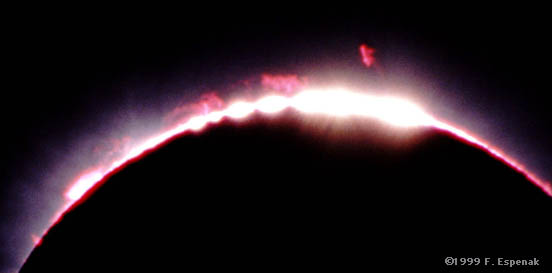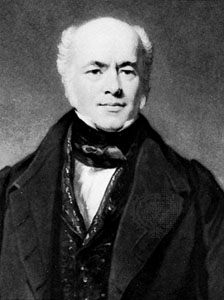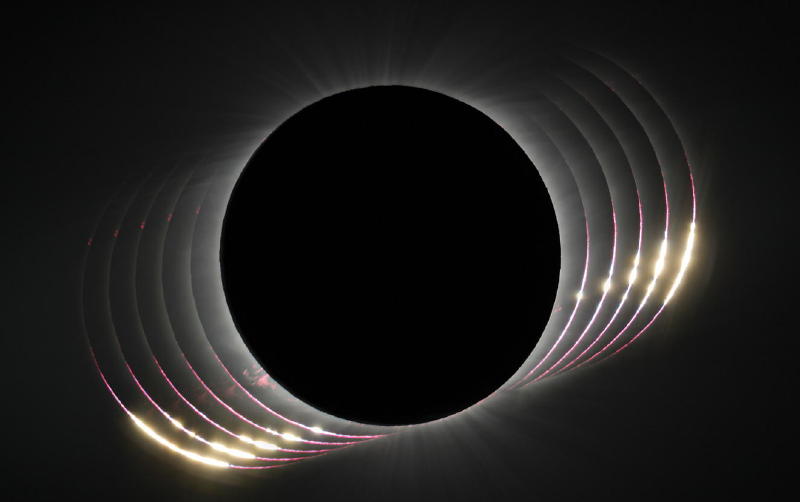
May 15, 1836: On this date in science, Francis Baily (1774-1844), an English astronomer, saw beads of sunlight shining along the edge of the moon’s silhouette during an eclipse of the sun.
It was an annular eclipse – nowadays often called a ring of fire eclipse – meaning that the moon was too far away in its monthly orbit around Earth to appear large enough in our sky to cover the sun completely. Baily saw beads of light shining around the darkened lunar limb (edge of the moon).

Baily’s discovery
Baily’s goal was to time the length of the annular phase of the eclipse. He would do this by recording the time during which the moon was inside the sun’s disk. He would start timing as soon as a line of sunlight appeared along the trailing edge of the moon.
Baily expected to observe a nice, smooth line of sunlight along one edge of the moon. Imagine his surprise as he watched and waited for it to appear – while observing with a filtered 2.6-inch, f/16 refracting telescope – at 40 magnification. Instead of seeing a smooth line of sunlight, he saw a broken line of light and dark spots.
Don’t start that stopwatch yet, Mr. Baily!
Baily and others have commented that the line of light and dark spots resembled beads on a string. And, as the seconds ticked by, Baily saw the dark spots decrease in both number and size. And he saw the light spots increase in both number and size, until there was a fine line of sunlight around the edge of the moon.
Okay, now start the stopwatch!
But after the moon was completely inside the solar disk, the moon did look “smooth and circular” to him. At least four other local observers confirmed this observation during this eclipse.
Sunlight shining through lunar valleys
Later, others realized that these beads of light appeared due to mountains and valleys, crater walls, and other topographic features extending above the limb, or edge, of the moon as seen from Earth. This phenomenon earned the name Baily’s beads. And you can see it during total eclipses, too, just before the moon covers the sun completely. A video of Baily’s beads is here.
Baily published his discovery in the Monthly Notices of the Royal Astronomical Society in December of 1836. In a talk to the Royal Astronomical Society, he mentioned that he knew of only one other person who had seen these before, that being Jean Henri van Swiniden (1746–1823), a Dutch scientist.
Today, Baily’s beads are one of the eclipse effects that amateur astronomers around the world – using proper eye protection – watch for during annular and total eclipses of the sun.

Baily’s beads during a total eclipse
Baily discovered the beads during an annular eclipse, but they’re best known for being visible during a total eclipse. Let’s look at the process during a total eclipse.
During a total eclipse, the moon moves across a sun that takes up the same amount of sky. As the leading edge of the moon moves toward covering the remainder of the sun, dark spots interrupt the last bit of sunlight. Those are lunar mountains. Totality has not yet begun, as sunlight is still peeking between these dark spots.
As the seconds tick by, the sunlight decreases, and the dark areas increase until there is only one spot of light on the limb of the moon: the diamond ring. When that final bright spot disappears, the total eclipse begins. Remove the solar filters for a fantastic view.
As the total phase draws to a close, the effects resume in reverse order. On the trailing side of the moon the sunlight appears. First, the diamond ring. Next, Baily’s beads. Watch a video of Baily’s beads during the August 21, 2017, total eclipse here.
The Baily’s beads phase is unappreciated during total eclipses. The main show is totality, and observers are typically preparing to remove their solar filters while Baily’s beads and the diamond ring are occurring. And those Baily’s beads at the end of totality? They are accompanied by sighs as the total phase comes to an abrupt end. But you can watch the phenomena at the end of the total eclipse with unfiltered and dark-adapted eyes, so they might appear brighter and more noteworthy than those leading into the total phase.

Baily’s beads during an annular eclipse
Here is the process during an annular eclipse, the type that Baily saw. To start, the moon appears smaller than the sun, so you must use filters the entire time. At the center of the annular eclipse, you see a ring of the sun around the moon. And the episode begins on the trailing, not the leading, edge of the moon. As the last bit of the moon moves onto the sun, the uneven dark limb (edge) of the moon produces bright spots. These bright spots increase in number and size until the whole edge of the moon is a bright arc of sunlight.
That is what Baily saw. Toward the end of the annular phase of the eclipse, now looking toward the leading edge of the moon, that bright arc of sunlight begins to be interrupted by dark spots, growing in size. A video of Baily’s beads during an annular eclipse is here.
Extending the beads
Is there a way to make those beads visible for a longer length of time? Yes, there are two ways. One is to hop onto a jet and zoom along the path of the eclipse. This will also extend the length of the total phase of the eclipse.
The other way is to set up near the edge of the central path of the eclipse. The typical eclipse shows the main event, whether annular or total, only along a path on the earth that is about 100 miles (160 km) wide. Sit in the center of that path and the eclipse phase will last longer than near the north or south limit of this path. But if you go near the north or south limit, the Baily’s beads phase will last longer, at the sacrifice of the central phase. A video of Baily’s beads lasting more than two minutes is here.

Baily’s beads or Halley’s beads?
On April 22, 1715 (Julian calendar, or May 3, 1715, Gregorian calendar) Edmond Halley (1656-1742) observed a total solar eclipse from London. He predicted the eclipse, and so it is often referred to as Halley’s Eclipse. During this total eclipse, Halley observed Baily’s beads too, 59 years before Baily was even born. Here is Halley’s description:
About two Minutes before the Total Immersion, the remaining part of the Sun was reduced to a very fine Horn, whose Extremeties seemed to lose their Acuteness, and to become round like Stars … which Appearance could proceed from no other Cause but the Inequalities of the Moon’s Surface, there being some elevated parts thereof near the Moon’s Southern Pole, by whose Interposition part of that exceedingly fine Filament of Light was intercepted.
This is an excellent description of Baily’s beads, even though Halley hit the “shift” key a few too many times!
Edmond Halley was the first to observe and identify the event we now call Baily’s beads, yet they are not named after him. What is named after Edmond Halley?
Halley’s Comet, which he did not discover, but he did predict its return.
Halley’s Eclipse in 1715, which he also predicted.
Halley, the crater on the moon, named long after Halley passed away.
Halley, the crater on Mars, named in 1973.
Halley Research Station, in Antarctica, established in 1956. Edmond Halley never went to Antarctica, nor to the moon nor Mars, for that matter.
Halley’s Mount, a hill on the island of Saint Helena, from where Halley observed the southern sky.
But we don’t have “Halley’s beads,” even though he discovered and defined them. One suggestion is to refer to the beads seen during the annular eclipses as Baily’s beads and the ones seen during the total eclipses as Halley’s beads. Then Edmond Halley would finally be recognized for something he discovered.
Bottom line: May 15, 1836: Francis Baily, an English astronomer, saw light shining through lunar ridges during an eclipse of the sun. These are now known as Baily’s beads.
The post Baily’s beads seen during a solar eclipse first appeared on EarthSky.
0 Commentaires